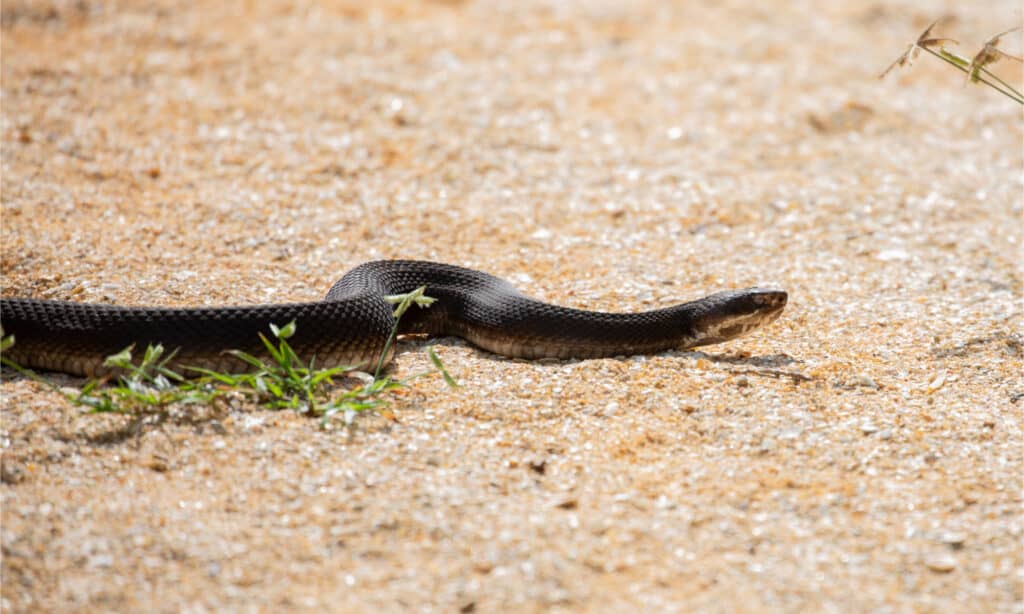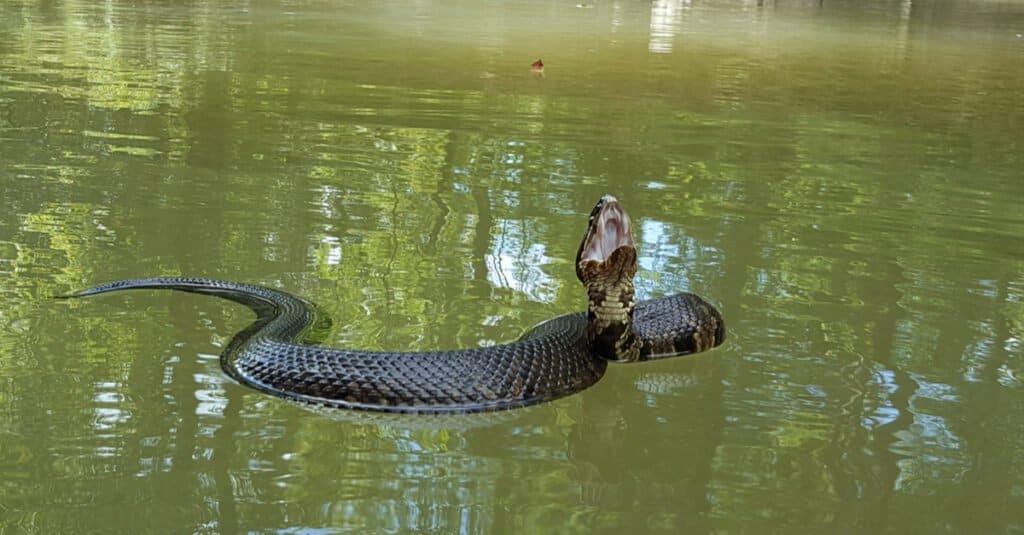During warmer weather, it becomes more common to see snakes, including cottonmouths, in Illinois. As a result, if you’re planning to take a trek outside during the spring or summer, it’s beneficial to learn more about this interesting species.
Ready to learn more about cottonmouths in Illinois? Keep reading below!

During warmer weather, it becomes more common to see snakes, including cottonmouths, in Illinois.
©Linda Burek/Shutterstock.com
About Cottonmouths
Cottonmouths are also known as water moccasins. They’re a common venomous snake found in the United States, including in Illinois. Their scientific name is Agkistrodon piscivorus. While some scientific names can often seem random or unrelated to the species, you can actually learn a lot about cottonmouths by breaking down their scientific name.
The word agkistrodon is derived from the Greek word ankistron, which means “fishhook.” Now, there are two possible meanings for the cottonmouth being given this name. First, it could be a reference to the cottonmouth’s hooked fangs. These are common features of snakes in this genus. However, it could also be a reference to their diet, which the word piscivorus, that is, “piscivorous” refers to.
Cottonmouths favor aquatic environments. This is why they have the common name of water moccasins. Because they live in these environments, cottonmouths in Illinois often eat the prey available to them here, including fish. As a result, not only can the genus name be a reference to this, but their species name can be broken down to mean “fish-eater”!
Cottonmouths are a common type of venomous snake in Illinois. However, they can also be mistaken for other species. This is why learning to identify their appearance is important.

Cottonmouth snakes favor aquatic environments, which is why they are often called water moccasins.
©Seth LaGrange/Shutterstock.com
Appearance
When you first see a cottonmouth, you may not be able to identify it as such readily. In fact, you may be inclined to think that a cottonmouth is a different species of snake. Their dorsal side, or back, is almost identical to many other species. This is because they tend to come in darker colors, such as dark red with brown or black markings, traits that many different species spare. However, there are a few key ways to identify a cottonmouth in Illinois by its appearance.
The best way to tell if a snake is a cottonmouth from afar is to get a glance at its mouth. Just like their scientific name has a meaning, so does their common name! The name “cottonmouth” comes from this snake having a stark white mouth on the inside.
Cottonmouths are also larger snakes, much bigger than the harmless snakes you may see on a day-to-day basis. Adult cottonmouths can grow to be anywhere from 2 to 4 feet long. However, they’ve been known to grow larger. In fact, the largest cottonmouth measured over 6 feet long.

You can identify a cottonmouth snake from other snake species by its mouth, which is stark white on the inside.
©Marcum Havens/Shutterstock.com
What Time of Year Are Cottonmouths in Illinois Most Active?
Like other species of reptiles, cottonmouths in Illinois favor warmer weather. As a result, they are most commonly active in the spring and summer months when the temperature is the perfect balance between not-too-cold and not-too-hot. This time most commonly falls in the period between March and May.
What Time of Day Are Cottonmouths in Illinois Most Active?
Cottonmouths are a nocturnal species of snake. As a result, they’re most active during the evening hours and at night, when they can be seen hunting. This doesn’t mean they’re scarce during the day, however. They just prefer to spend their daylight hours resting and basking in the sunlight.
What to Do if You See a Cottonmouth
Now that you know more about cottonmouths in Illinois and when they are most active, you may wonder what to do if you see one. After all, this is a venomous snake that is common in areas that attract people, such as lakes and slow-moving rivers.
When you see a cottonmouth, you should treat it as you would any snake. All snakes, venomous or not, are wild animals and deserve respect. This is the best way to prevent any danger to you and these amazing reptiles.
So, the first thing you should do if you see a cottonmouth is step away and not approach the snake. If the snake moves in your direction, it’s not chasing you: it simply wants to leave and needs to go in that direction. As a result, just step aside and leave enough distance for the snake to pass.
Snake bites almost never happen for no reason. A majority of snake bites happen by a snake that has been seen and is being interacted with. No matter the snake, it’s important to remember that these are wild animals and shouldn’t be handled.
The photo featured at the top of this post is © Paul S. Wolf/Shutterstock.com
Discover the "Monster" Snake 5X Bigger than an Anaconda
Every day A-Z Animals sends out some of the most incredible facts in the world from our free newsletter. Want to discover the 10 most beautiful snakes in the world, a "snake island" where you're never more than 3 feet from danger, or a "monster" snake 5X larger than an anaconda? Then sign up right now and you'll start receiving our daily newsletter absolutely free.
Thank you for reading! Have some feedback for us? Contact the AZ Animals editorial team.






